Richard Bell on
The Aboriginal Tent Embassy,
on Art and Activism, Social Justice, Land Rights,
and the Power of Art

Richard Bell and the ' Aboriginal Tent Embassy' at Perth Institute of Contemporary Art, Perth, 2014. Photograph: Toni Wilkinson
© Richard Bell, © Milani Gallery, Brisbane
Working as a field officer for the NSW Aboriginal Legal Service in the 1980’s, protesting for land rights for Aboriginal People and against injustices, Richard Bell came into art highlighting his activism through his artworks alongside his writings.
A descendent of the Kamilaroi, Kooma, Jiman and Goreng Goreng Peoples, Bell grew up in Queensland in an Aboriginal community, witnessing his home being destroyed by local authorities, after a 1967 vote declared that the (then) government could make laws for Aboriginal People.
Bell’s work is a form of resistance against prejudice, injustice, racism, othering and stereotyping. His artworks encompass paintings, installations, performance art and video, delving into the notion of power, colonialism, and control over Indigenous Art.
In 2002, he wrote 'Scienta E Metaphysica, Bell’s Theorem, Aboriginal Art It's a White Thing!', an essay contesting the "Western" art history narrative and on how Aboriginal Art was turned into a commodity, not controlled by Aboriginal People. The painting of the same title, won the 20th Telstra National Aboriginal Arts Award in August 2003, and that same year, Bell co-founded proppaNOW with the aim to highlight urban-based Aboriginal artists.
Exploring cultural appropriation within History of Art in Bell's Theorem, Richard Bell cites Picasso and African Art, and as part of his activism, often employs in his own paintings art techniques which have been linked with artists from Pop Art to Abstract Expressionism.
In June 2023, upon entering Turbine Hall at Tate Modern, viewers were greeted with the artist’s installation ‘Pay The Rent’, a large electronic red number increasing quite rapidly. The artist intentionally provided no sign to declare what the work evokes, leaving the art installation to draw the viewer in. And it did; providing a sense that the number is important and it should be taken notice of.
One level up at Tate Modern, on display, was Richard Bell’s 'Aboriginal Tent Embassy'. A tent for protest, highlighting, learning, hearing, discussing, and standing up for human rights. Encircled by protest signs, it is a site to hold conversations on causes and rights. A tribute by Bell to the original Aboriginal Tent Embassy of 1972 which had been placed on the lawn opposite Old Parliament House in Canberra to protest against the then government’s politics, and for Aboriginal land rights.
Richard Bell’s tent has travelled to Moscow Biennale,VDNKh in 2013, Perth Institute of Contemporary Art in 2014, in 2015 to the Jakarta Biennale and at Performa, New York, and in 2016 at the Cairns Indigenous Art Fair and the Museum of Contemporary Art Australia fore-court for the 20th Biennale of Sydney, Brisbane festival.
Rooted in activism, Bell’s work is impactful and powerful, connecting his message of social justice through his significant art. He wants people to engage with each other, for discussions to occur, perspectives to be heard. We spoke to the artist about his tent and installation at Tate Modern, on how they came about and what they represent, with our conversation starting on his beginnings in art, and what his aims have been and continue to be...
How did you first approach art?
I started making tourist art, that was my first introduction to it.
You wrote 'Bell's Theorem', (full title: Scienta E Metaphysica, Bell’s Theorem, Aboriginal Art It's a White Thing!) in 2002, which looks at Aboriginal Art being used as a commodity, power dynamics and the rights of the artists not taken into consideration. What led to developing your essay?
Looking around at what was happening, listening to discussions that people had been having for many years about Aboriginal Art and its exploitation. People were talking about it for a very long time.
Link: Bell's Theorem
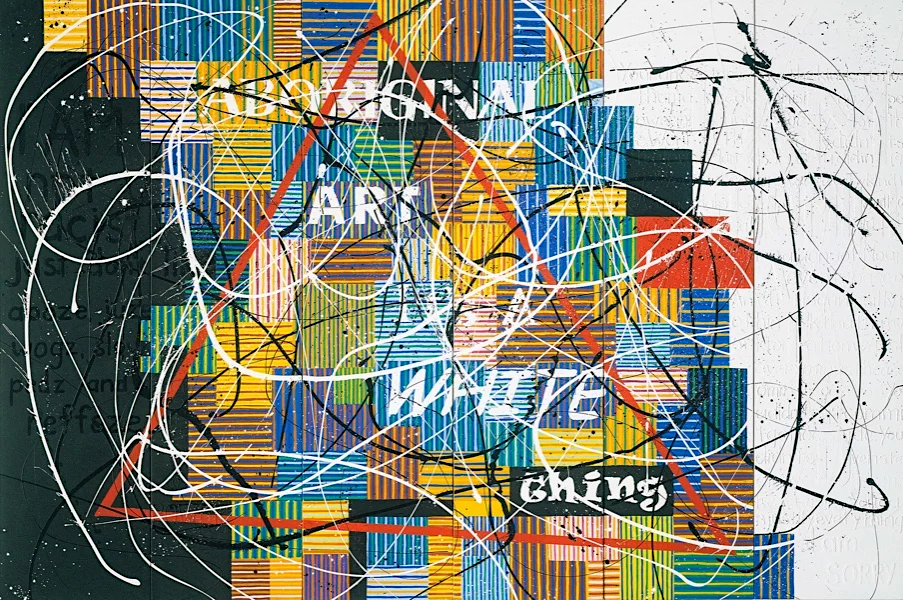
Scientia E Metaphysica (Bell’s Theorem), Richard Bell, 2003, Acrylic on canvas, 240 x 540cm. Milani Gallery. © Richard Bell, © Milani Gallery, Brisbane
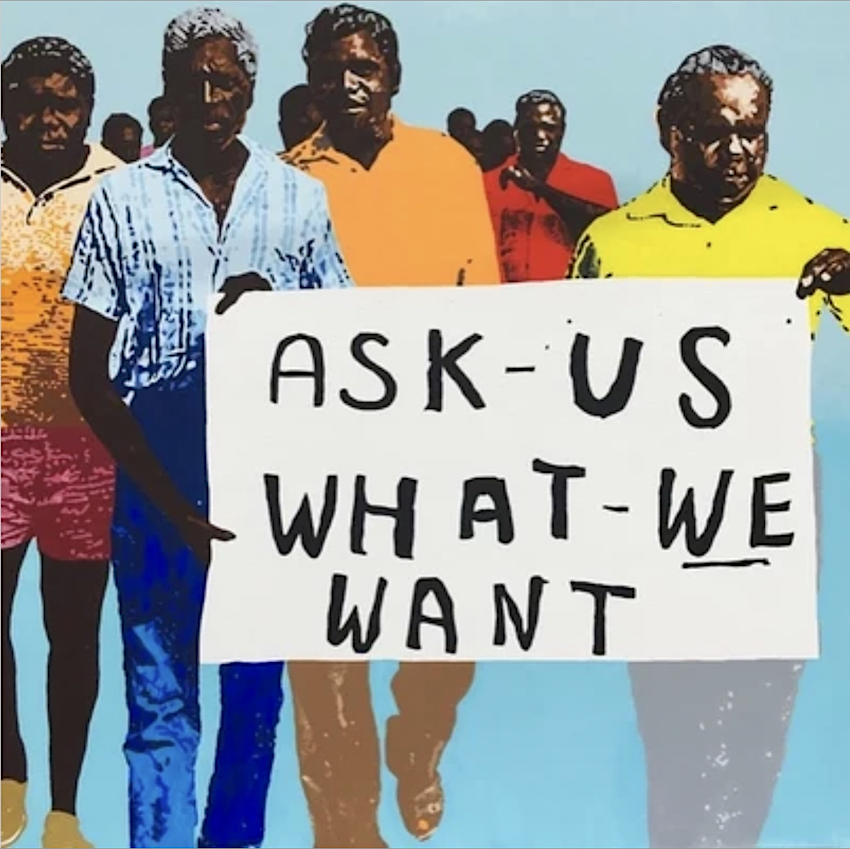
The Sign Says It, Richard Bell, Acrylic on Canvas, 2017, 200 x 200 cm, © Richard Bell, © Milani Gallery, Brisbane
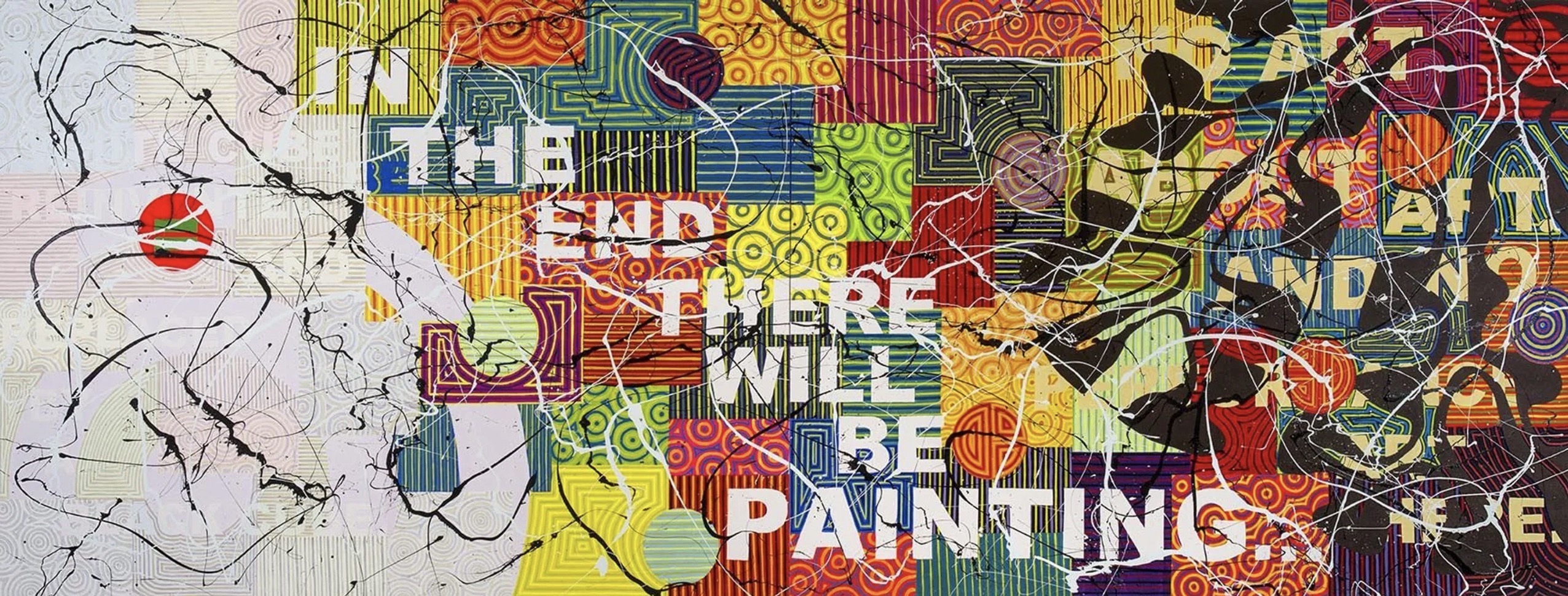
Omega (Bell's Theorem), Richard Bell, 2013, Acrylic on linen, 180 x 480 cm, © Richard Bell, © Milani Gallery, Brisbane
You founded proppaNOW, an arts collective to give a voice to urban-based Aboriginal artists, and counter any stereotypes, can you tell us a bit about the collective and its aims?
proppaNOW is a group that my friends and I put together with the aim to bring some focus to the work of East Coast based artists in contemporary art, as the attention was very much on art from the rural areas. We thought that if we started a collective, we would at least draw some attention towards our work. We had some success, and last year we were awarded the Jane Lombard Prize for Art and Social Justice. That activated us a lot. We also quickly realised that there wasn't any youth amongst us, so we invited three younger people to join us and go forward. Turning proppaNow into a collective of nine.

Tony Albert, Jennifer Herd, Gordon Hookey, Megan Cope, Richard Bell, Vernon Ah Kee. Photo: Rhett Hammerton
Queensland arts collective proppaNOW was set up in Brisbane in 2003 to give urban-based Aboriginal artists a voice, a supportive setting to delve through art into social and cultural issues and raise awareness of Aboriginal urban expression within contemporary art. proppaNow

We Can Change The World, Every Single Revolution on Earth was Started By Small Groups Of People, Richard Bell
The proppaNOW exhibition 'Insurgence' opened at the Museum of Australian Democracy at Old Parliament House (or MOADOPH for short). proppaNOW’s exhibition ‘Insurgence’ opened at the Museum of Australian Democracy on October 22nd 2013.
In regards to the aims you had with proppaNOW, do you feel things are getting better, have you seen a change?
It’s hard to say. I was just speaking about this. proppaNOW brought out a press release almost twenty years ago, which set some tasks that we thought were reasonable expectations. I went through all of them with one of the newer members of our collective, and only found one of the aims we had issued where there has been some improvement, all the rest there has been no activity on.
Hopefully, things will get better from now on
There is no hope.
Where there’s art, there’s hope?
Like I always say, hope less, do more.
I wrote two essays, one 21 years ago, and one last year, internationalising the discussion about the situation.
That around the world some may have a related experience
Well yes, particularly a thing called colonisation.
Can you talk us through the origins of the Aboriginal Embassy, what does the space evoke and the aims it had and has to highlight the rights for Aboriginal People?
The original Aboriginal Tent Embassy was formed more than 50 years ago on the 26th January 1972. The previous evening, four young men (Michael Anderson, Billy Craigie, Tony Coorey and Bertie Williams) left Sydney for Canberra to establish an Aboriginal Embassy, as the issue of sovereignty in Australia had not been dealt with. There were no treaties with the Aboriginal People on the basis of the sovereignty of the English that had been set in as Terra Nullius, which is a latin term for an empty land or land with no people.
Our people were fighting for land rights, but the government of January 1972 declared that they would never give out land rights to the Aboriginal People. So, a meeting took place in Redfern, a suburb of Sydney, where the decision was made for those four men to establish a presence in the national capital to protest that statement.
The first Tent Embassy was actually a beach umbrella, as the men didn’t have a tent with them and they didn’t have a budget for one, they tried to borrow a tent, but none of the Aboriginal People had one, so they asked some people who worked in the department of Aboriginal fairs if they had a tent, they didn’t either. However, one of them had a beach umbrella, and that became the first Aboriginal Tent Embassy.
It took about 6 months for the government to respond, they changed the legislation to make it illegal to camp on the lawns across from Parliament House. During that time, thousands of Aboriginal People from all parts of the country came to protest. Then in the years 2009, 2010, 2011, 2012, I noticed that young people were setting Aboriginal Tent Embassies around the country, not just in the cities but also in the small country towns. I thought wow this is phenomenal; this is a phenomenum! And so I decided that I would make a tribute to that, and in 2013, I showed the 'Aboriginal Tent Embassy' at the Monash University Museum of Art in Melbourne.
How was your experience bringing it over to Tate Modern, how did that all unfold?
It was really quite something, a huge honour. By having the Embassy there, we were able to assemble together some pretty amazing people.
I’m glad many turned up for the conversations, I highlighted some of the issues the local people had, invited them to come along, they had their say on their concerns.
https://www.tate.org.uk/visit/tate-modern/display/richard-bell-embassy#programme
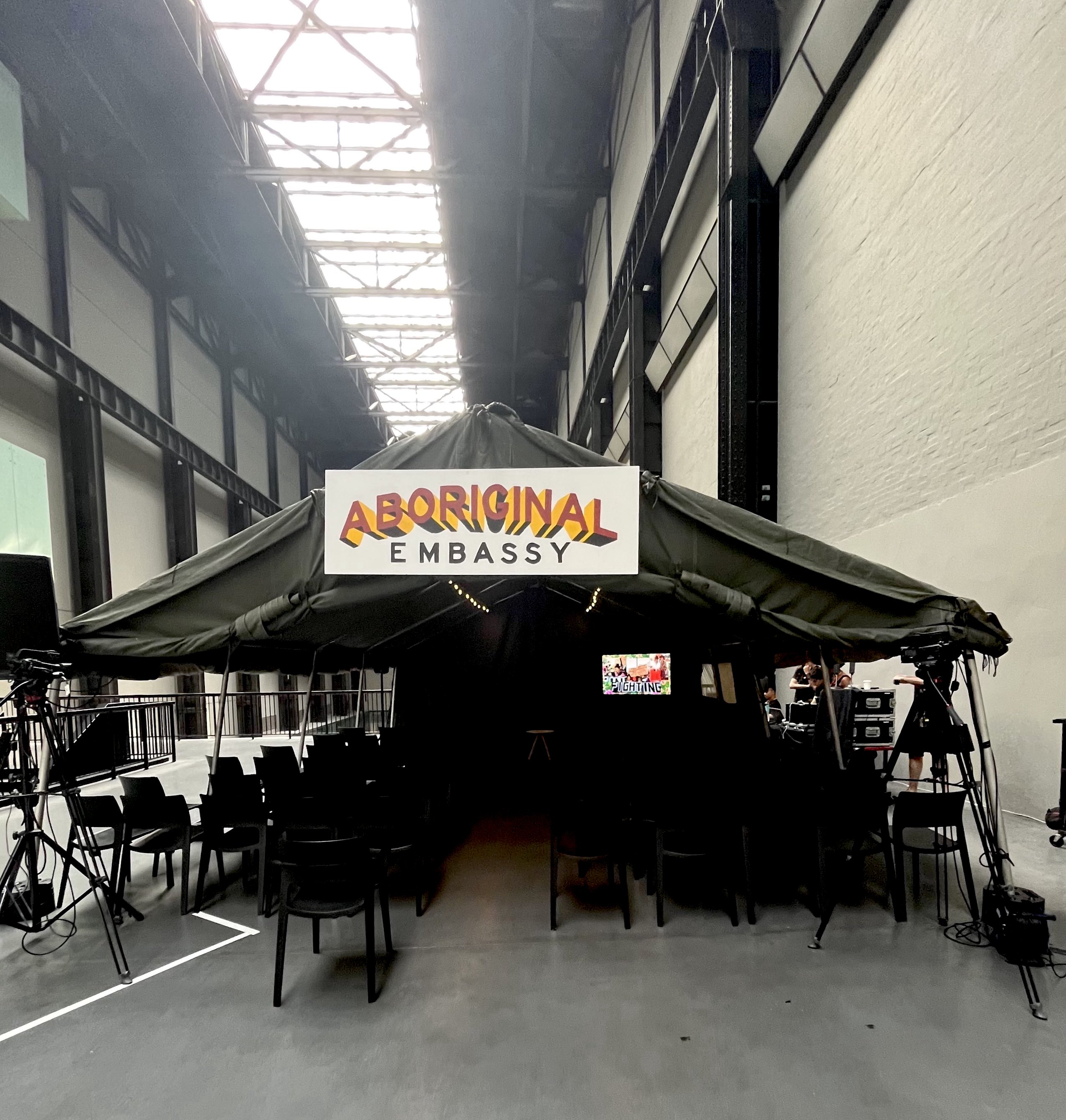
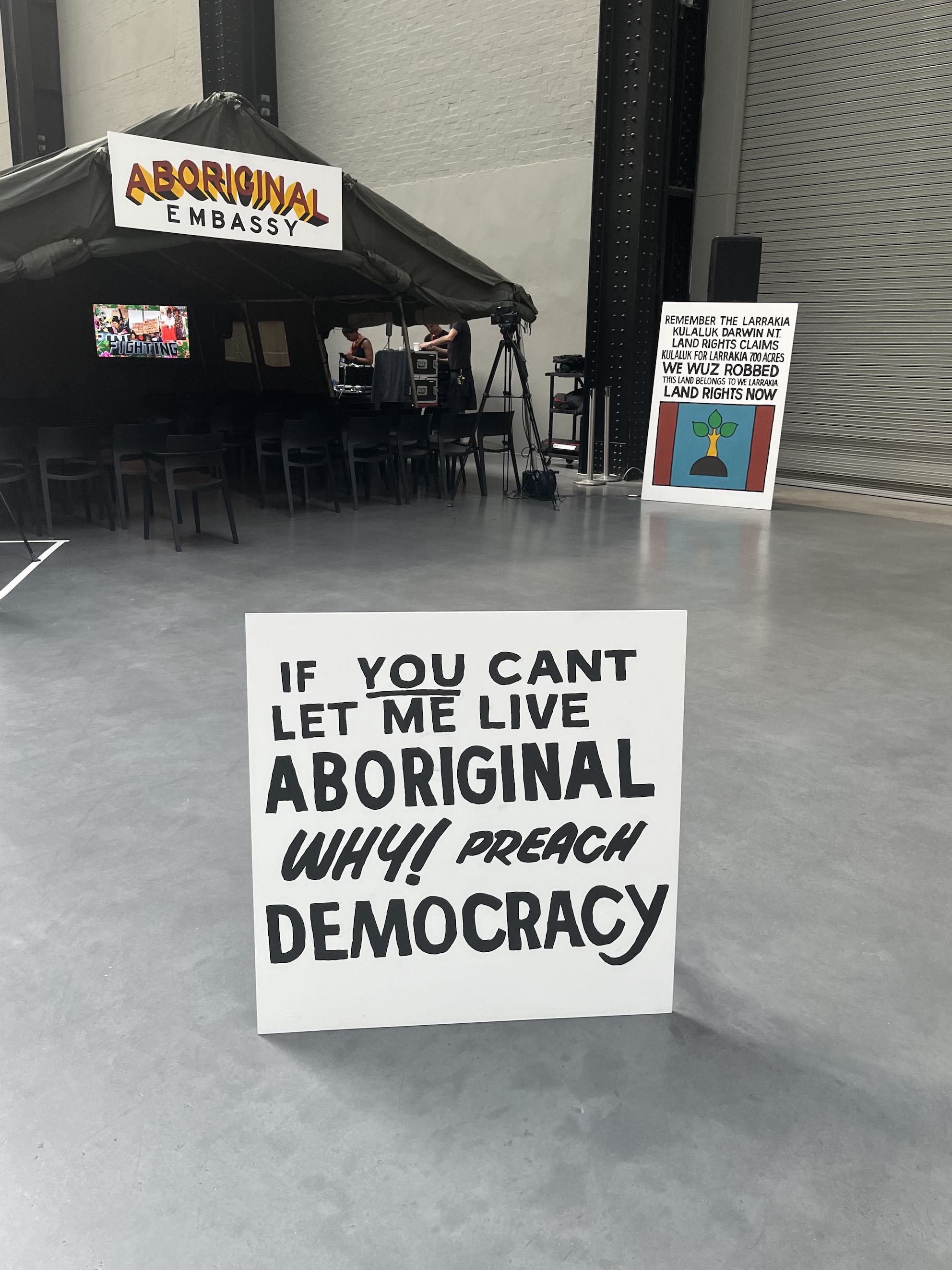
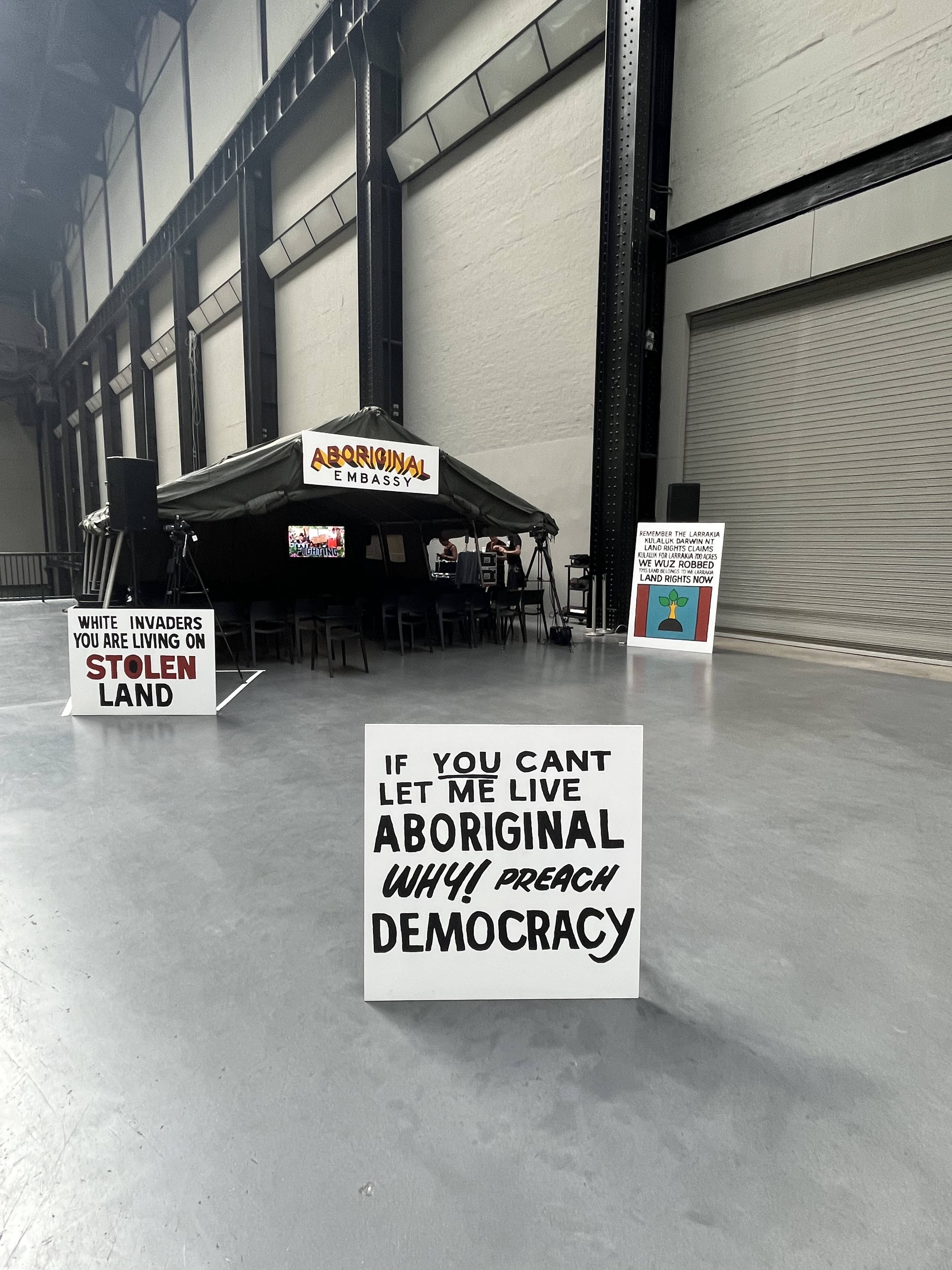

Aboriginal Tent Embassy by Richard Bell at Tate Modern, June 2023
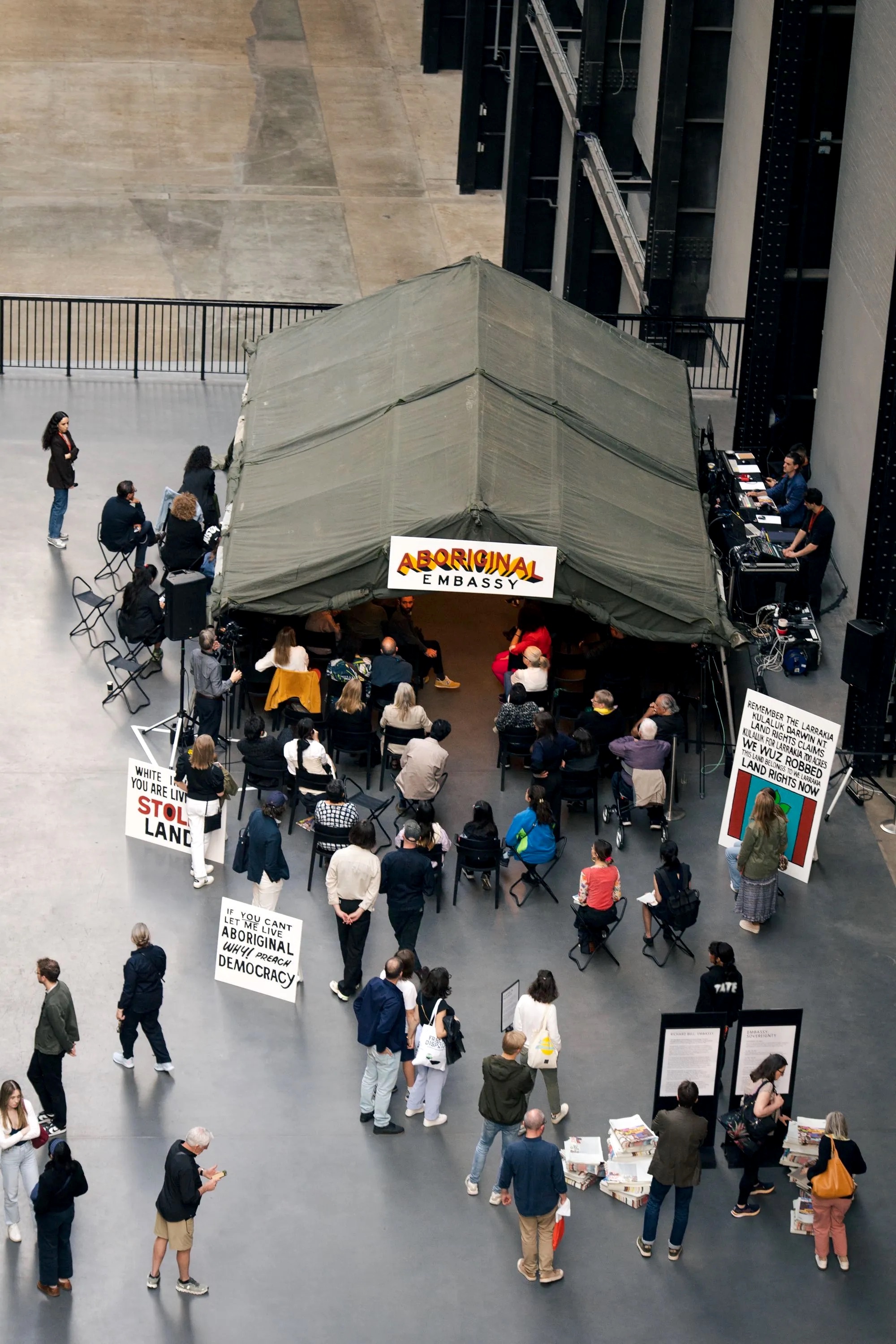
Aboriginal Tent Embassy by Richard Bell at Tate Modern, June 2023, © Richard Bell, © Milani Gallery, Brisbane
Upon walking into the Tate Modern, on view is your work 'Pay the Rent’. How and when did this work come to be and what is the number about?
The ‘Pay the Rent’ installation came about last year for Documenta. The figure reflects what the Australian Government owes the Aboriginal People from 1901 after the British handed over control.
I was sitting in the park in Union Square in New York City, where there was a sign with a number depicting days or something like that, and I thought, well I want to do that, but instead have a figure that calculates and brings into view the amounts of money that are owed to the Aboriginal People, just for the use of the land. It's just about the rent, the number on view does not take into account the resources that were stolen or the compensation for crimes that were committed against us. It’s an indication that colonisation needs to have consequences for its actions.
It’s impactful, it hits the viewer straight away upon entering the Turbine Hall at Tate Modern
I couldn’t imagine it there, so when I first saw it, there was a high impact. People upon arriving, want to know what it’s about, there wasn’t a banner about the work, which I also did in Kassel for Documenta, and that’s because I want people to talk to each other, to ask what the number could be. I thought that maybe in London it might have to have some explanatory sign, but it appeared not.
One mathematician wanted to know how I calculated the figure for 'Pay The Rent', I told him the figure came to me, and that I had a mathematician back in Australia working on something so people like him can be satisfied! You know, it’s a conceptual artwork.
'Pay The Rent' and 'The Aboriginal Tent Embassy' encourages our communication, to engage with one another, and for people to reflect on things.
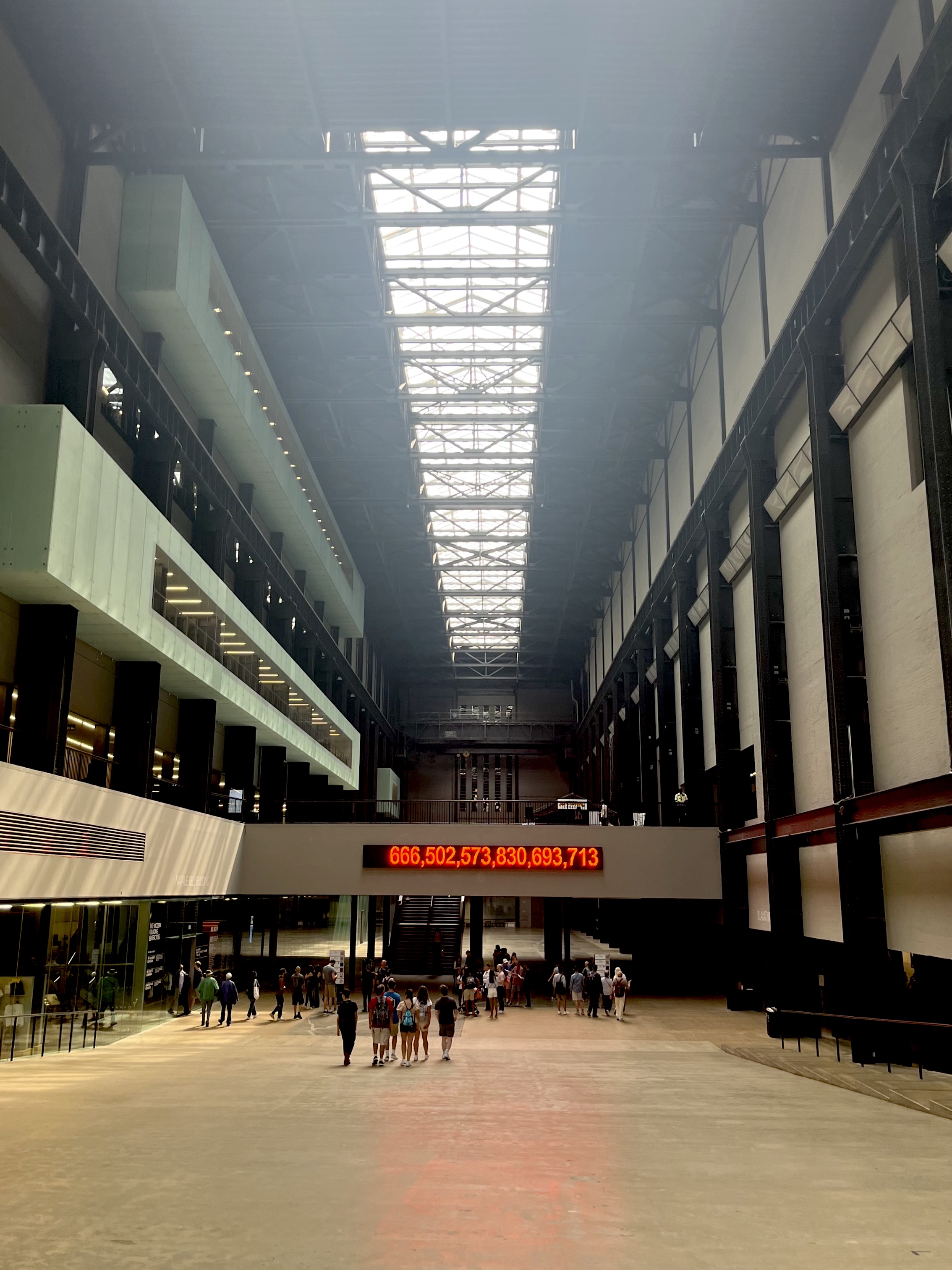
'Pay The Rent', Richard Bell, Turbine Hall Tate Modern

'Pay The Rent', Richard Bell, Turbine Hall Tate Modern
I wanted to talk to ask you about taking back the power of cultural appropriation through art, when did that process come about?
I brought that to art with me. I was an activist and I brought that activist attitude with me to my art. That was always going to be my approach.
%202004.png)
'Interior (Possum Dreaming)', Richard Bell, 2004, © Richard Bell, © Milani Gallery, Brisbane
When you paint do you think of yourself more as an activist or a painter? Or a bit of both?
I just make the work. I’m not thinking of things in that mode, I’m just presenting the art, and people make what they will or what they want of it. And they do.
What are your thoughts on the power of art, do you think it can unite people? Or not always?
Not always. Communities are made up of lots of different people and lots of different backgrounds, with lots of different opinions. It's very difficult, so I don’t have any expectations, but I like to have discussions about these issues and all these topics, rather than not.
For me, its very important that discussions happen.
And art is a way to bring about those discussions
Yes well, we have artistic and academic freedom, art is probably for me the best way to participate in these kind of actions. It’s much more effective in the long run, because these things are kept on record. We can say what we want and what we need to say.
.jpg)
Richard Bell, 2022, Kochi-Muziris Biennale 22-23, Kochi Biennale Foundation, India, © Richard Bell, © Milani Gallery, Brisbane
Richard Bell (b. 1953) lives and works in Brisbane, Australia. He works across a variety of media including painting, installation, performance and video. One of Australia’s most significant artists, Bell’s work explores the complex artistic and political problems of Western, colonial and Indigenous art production.
In 2023 Bell presented his major work Embassy (2013–ongoing) at Tate Modern, London.
He grew out of a generation of Aboriginal activists and has remained committed to the politics of Aboriginal emancipation and self-determination. In 2003 he was the recipient of the Telstra National Aboriginal Art Award, establishing him as an important Australian artistic figure. Bell is represented in most major National and State collections, and has exhibited in a number of solo exhibitions at important institutions in Australia and America. In 2013 he was included in the National Gallery of Canada’s largest show of International Indigenous art, Sakàhan, and at the Fifth Moscow Biennale of Contemporary Art. In 2014, Bell’s solo exhibition Embassy opened at the Perth Institute of Contemporary Arts, Perth. In 2015, Bell was a finalist in the Archibald Prize, presented a collaborative exhibition of new work with Emory Douglas at Milani Gallery, and exhibited his major work Embassy 2013-ongoing as part of Performa 15, New York City and the 16th Jakarta Biennale, curated by Charles Esche. Bell also premiered a body of new work as part of the Queensland Art Gallery/Gallery of Modern Art’s 8th Asia Pacific Triennial of Contemporary Art, Brisbane. In 2016, BELL invites… an exhibition of Bell and work by friends and collaborators opened at the Stedelijk Museum SMBA, Amsterdam. Bell also presented Embassy as part of the 20th Biennale of Sydney, curated by Stephanie Rosenthal, and premiered a new sculptural commission in Sonsbeek 2016 at the Dutch Art Institute in Arnhem, Netherlands. In 2020, Bell had a solo presentation at the Museum of Contemporary Art, Sydney. In 2022 Bell presented major works at documenta fifteen, Kassel, Germany; a solo presentation at the Castello di Rivoli Museo d’Arte Contemporanea, Torino, Italy with a solo project conceived as part of ESPRESSIONI CON FRAZIONI and a new body of work for RELINKING at the Van Abbemuseum, Eindhoven.
Richard Bell's Newspaper at The Aboriginal Tent Embassy, with prints of his impactful paintings:
© Richard Bell, © Milani Gallery, Brisbane

Sol, Richard Bell, 2021, synthetic polymer paint on canvas, 200 x 200 cm, Private collection, Brisbane. © Richard Bell, © Milani Gallery, Brisbane

Hand-outs Protest, Richard Bell, 2021, synthetic polymer paint on canvas, 180 x 240 cm, © Richard Bell, © Milani Gallery, Brisbane
End Capitalist Control, Richard Bell, 2023, synthetic polymer paint on canvas, 180 x 180 cm, © Richard Bell, © Milani Gallery, Brisbane
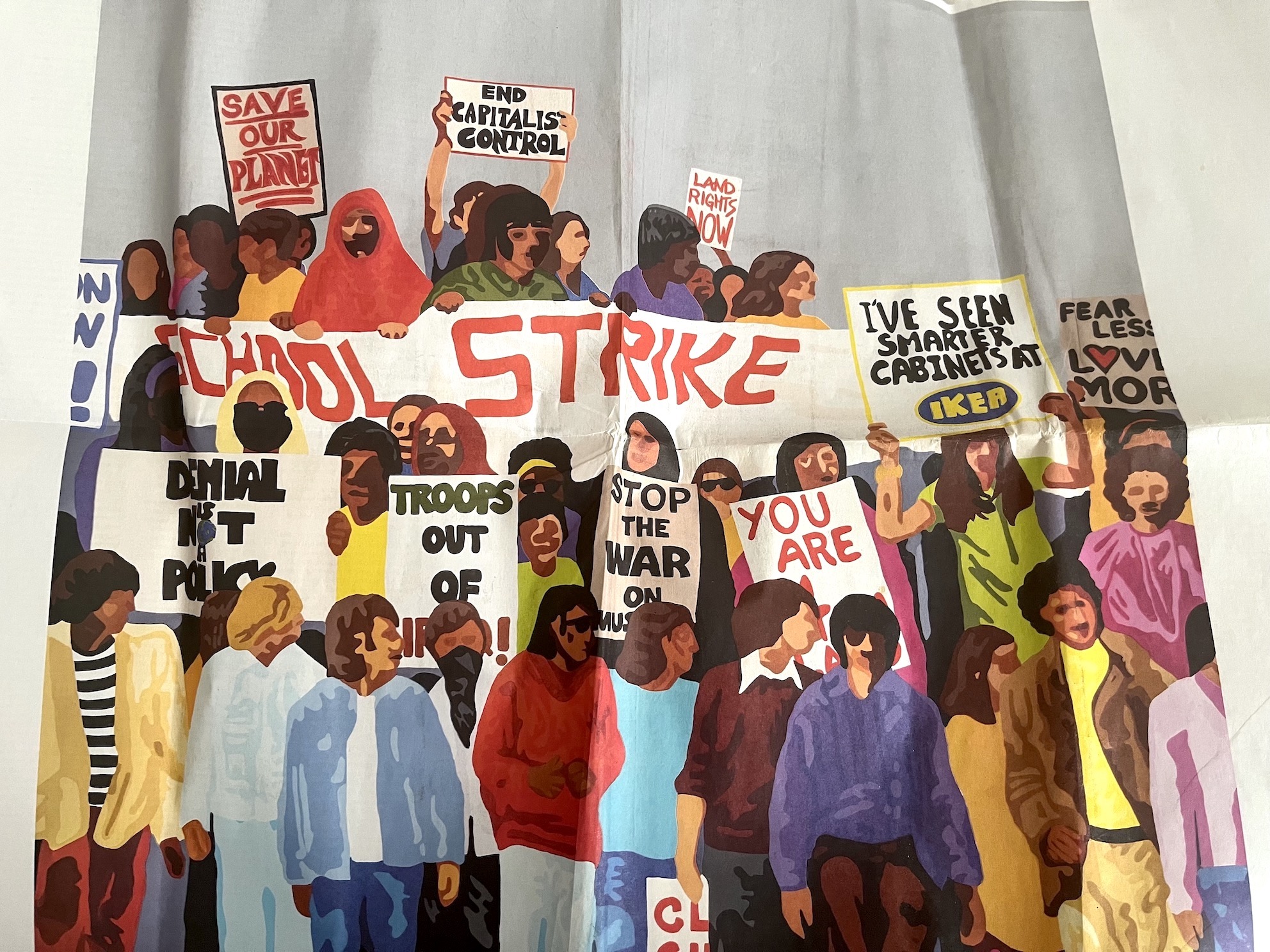
End Capitalist Control, Richard Bell, 2023, synthetic polymer paint on canvas, 180 x 180 cm, © Richard Bell, © Milani Gallery, Brisbane

Umbrella Tent Embassy, Richard Bell, 2023, synthetic polymer paint on canvas, 180 x 240 cm, © Richard Bell, © Milani Gallery, Brisbane
I Am a Man, Richard Bell, 2021, synthetic polymer paint on canvas, 180 x 240 cm, © Richard Bell, © Milani Gallery, Brisbane

Umbrella Tent Embassy, Richard Bell, 2023, synthetic polymer paint on canvas, 180 x 240 cm, © Richard Bell, © Milani Gallery, Brisbane
Pictures copyright © Richard Bell, © Milani Gallery, Brisbane
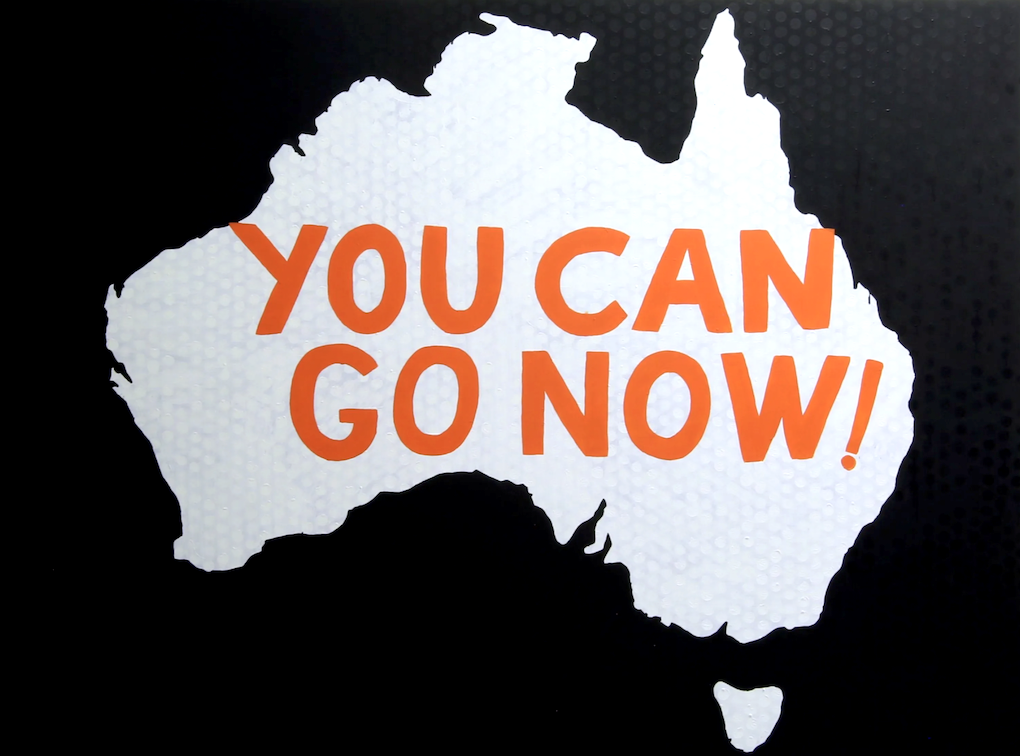
'You Can Go Now', Richard Bell, 2015, © Richard Bell, © Milani Gallery, Brisbane
